How to feed cucumbers with a mullein: preparation of fertilizer and the rules for its application
Any gardener knows that plants need feeding to get a rich harvest. The question of how to fertilize the garden so as not to harm the plant is acute. And although the market is flooded with a variety of complex remedies, many use manure in the old fashioned way. Such dressings will never lose their relevance, since they do not contain toxins and do not harm humans.
Feeding cucumbers with mullein: how useful it is, what types of manure are distinguished and how to use it correctly - read more about this in the article.
The content of the article
What is mullein
Mullein, or cow dung, is a natural fertilizer. Gardeners have been using it for years for feeding and raising yields plants on the site. It is believed that manure strengthens the immunity of crops, stimulates fruitingand protects against disease.
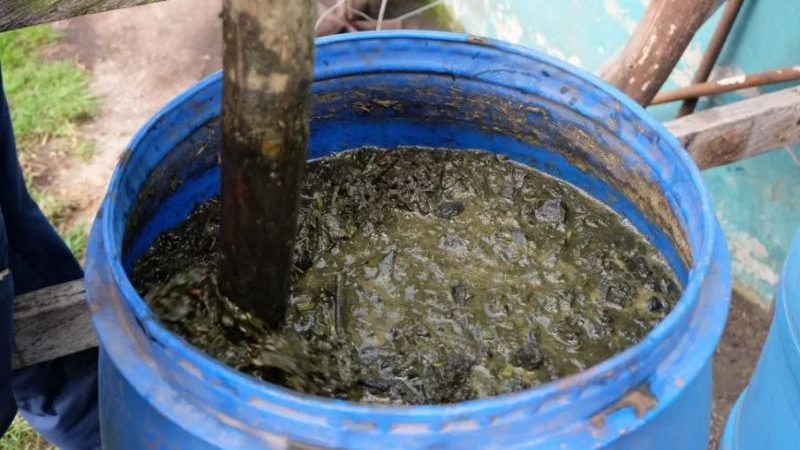
The mullein contains:
- sulfur;
- potassium;
- magnesium;
- phosphorus;
- nitrogen;
- calcium.
In addition to these basic elements, zinc, iron, boron, copper and cobalt are present in small quantities in cow dung.
reference... The introduction of one ton of fertilizer into the soil will enrich it with potassium by 6 kg, nitrogen by 5 kg, phosphorus by 2.5 kg.
In mullein, nitrogen and phosphorus are in an organic state. When manure decomposes, only 1/3 of these substances are released, the rest has a beneficial effect on vegetation. Potassium completely dissolves in water and is absorbed by garden crops after application feeding into the ground.
Which is better - mullein, chicken droppings, or horse dung
Each type of manure has its own rules for cultivation and use. Not all animal fertilizers are suitable for a particular crop.
Cow dung
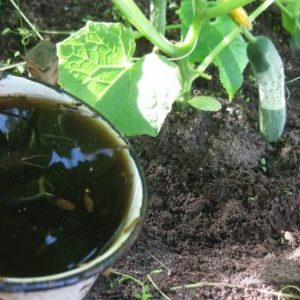
Mullein is used on plots everywhere due to its availability and low cost. This manure is suitable for most garden crops: tomatoes, cucumbers, eggplants, peppers, zucchini, cabbage, beets and carrots.
Top dressing is not recommended for legumes, radishes, radishes, onions and garlic, as it slows down plant growth and spoils the taste of the fruit.
The disadvantage of mullein is that fresh use is fraught with burns to the root system.
Horse dung
Horse manure is considered the most useful. It contains the maximum amount of silicic acid, which makes the stems of the plant strong and promotes the formation of healthy ovaries. This substance helps seedlings to absorb phosphorus.
The advantages of this fertilizer include its consistency - dense balls of manure are easier to use to prepare top dressing.
Important... Manure saturates the soil with oxygen and makes it looser. The fertilizer is suitable for feeding potatoes, cabbage, celery, cucumbers, zucchini, as well as melons.
Chicken droppings
This kind of manure popular with gardeners due to its high trace element content and availability. The composition of the manure depends on the conditions of keeping, the species and age of the birds, as well as the method of collecting fertilizer.
Fresh manure is not used due to the high concentration of nutrients.Top dressing is used to fertilize tomatoes, grain crops, potatoes, cabbage and beets. Chicken droppings are not suitable for cucumbers.
For feeding cucumbers, it is preferable to use horse manure, but not all gardeners have access to this type of fertilizer. Mullein will be a good substitute: although it contains fewer useful trace elements compared to horse manure, it is more affordable.
Mullein feeding of cucumbers
Organic fertilization has its advantages over chemical fertilization. Cow dung is used to feed fruit and agricultural crops, bushes and indoor flowers.
Benefits and properties
Manure application: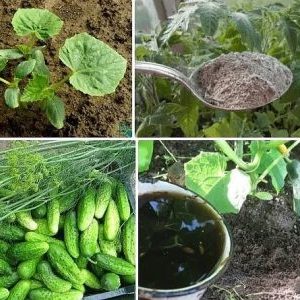
- Saturates the soil with beneficial microorganisms. Manure is a source of energy and food for bacteria, and ensures their reproduction.
- Improves the physical and chemical characteristics of the soil. Thanks to this feature, insoluble compounds in the soil become readily assimilated.
- Changes the structure of the earth. After adding the mullein, the soil takes on the appearance of small lumps, which is suitable for growing plants. Such a structure, saturated with humus, is less washed out by water.
Mullein is an organic fertilizer that stimulates plant growth. Thanks to top dressing, the seedlings are strengthened, the yield of cucumbers increases and the quality of the fruits improves. Also, manure has a beneficial effect on the immune system of the plant and protects against various diseases.
Important! Adding mullein to clay soil will make it loose. The soil warms up faster and is easier to handle.
Cooking mullein for feeding
Not all gardeners keep their cows, some prefer to purchase manure from livestock owners. The effectiveness of feeding depends on how the animal is kept in the stall.
Manure types:
- litter;
- liquid.
Litter manure contains straw. When stored, the fertilizer rots and becomes humus. The liquid type of mullein contains a large number of microorganisms, therefore it is used to prepare humus in a compost pit. Manure is mixed with weeds, sawdust, straw, vegetable tops.
To obtain fertilizer, 5 parts of liquid mullein and 2 parts of auxiliary components are used. For greater efficiency, lime or wood ash is added to the top dressing in an amount of 2-4% of the total mass.
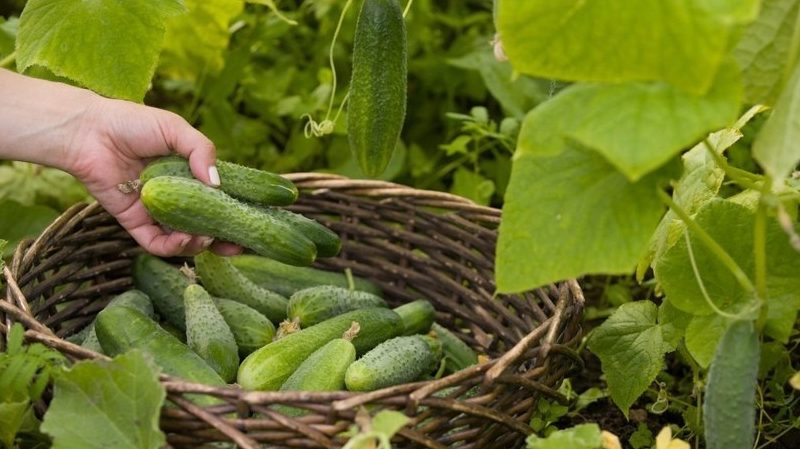
Mullein by degree of decomposition:
- Fresh - bring in in the fall when digging a site.
- Half-aged - used for introduction into soil and watering of plants. Soil fertilization rate - 4-6 kg per 1 m². An aqueous solution is prepared as follows - 0.5 kg of manure should be diluted in 5 liters of water, the mixture is insisted for a day. The liquid is suitable for watering the aisles.
- Overripe - to fertilize 1 m² of soil, 9-11 kg of manure will be needed. Aqueous solution - 5 liters of water per 1 kg of excrement. Manure is used to create a potting mix - it is mixed with garden soil 1: 2.
- Humus - the most valuable fertilizer. Used for application to the soil in the spring before planting - 2-3 kg of fertilizer per 1 m². It is also suitable for making potting soil. It will take 1.5-2 years to get humus.
Many gardeners use the bacterial method of decomposition of manure - they introduce special microorganisms into the droppings.
Is it possible to feed cucumbers with fresh manure
Fresh mullein is not used to fertilize cucumbers. Experienced gardeners do not recommend it, as top dressing can damage the roots and stems of the plant. Manure burns lead to the death of seedlings.
You can feed the soil without a threat to the plants if you apply fresh fertilizer in the autumn before digging the beds. Before the start of the new season, the manure will rot and will not damage the roots of crops.
Using rotted mullein
Manure is introduced into the soil in a half or completely rotted form.
Fertilizer preparation instructions:
- Pour leaves, straw or sawdust into a plastic barrel or pit.
- Pour liquid manure into the container.
- Refill additional components.
- Then comes the mullein layer, completely covering the previous layers.
- The barrel is filled until the contents reach the rim.
Cooking humus
Cow dung humus is the most useful fertilizer. It looks like a homogeneous, loose mixture of dark color.
To get this top dressing, fresh manure is piled up. Under the influence of oxygen, after 3-5 days, the inner layers are heated to + 60 ° C. This temperature burns out weed seeds and insect eggs, and nitrogen is lost.
To block the access of oxygen, the pile is compacted and covered with foil. Before winter, in order to prevent the loss of useful microelements, the manure is covered with a layer of earth 15 cm thick. In the spring, the soil is removed, and the film is left.
How to fertilize cucumbers with mullein
Mullein is good for cucumbers. This crop is highly dependent on the amount of nitrogen in the soil. Making fertilizer is easy, even a beginner can handle this task. However, there are several nuances of applying top dressing to the ground.
Timing
Fertilization of cucumbers with mullein is done several times per season. The first time feeding is applied 14 days after the appearance of the first shoots. Then the seedlings are fertilized once every 10-12 days. Keeping the spacing makes the plants comfortable and increases their yield.
Mullein feeding is stopped 3 weeks before the expected harvest.
Indications for feeding:
- lethargy of the plant;
- thin stems;
- wilting of foliage.
Instructions
Fertilizer with mullein is prepared in advance. You can prepare top dressing in a barrel or pit using the recipe above.
Another way is also popular: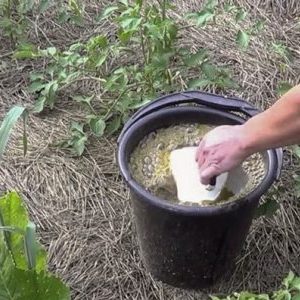
- Dilute mullein with water in a 1: 2 ratio.
- Leave the container with fertilizer for 7 days - after the expiration date, the gardener receives a concentrated solution.
- Before use, 0.5 l of the concentrate is diluted in 10 l of water.
- 10 liters of non-concentrated fertilizer solution is enough for 1 m² of beds.
Cucumbers are fertilized with mullein during watering. The liquid cannot be poured on top of the plant, the fertilizing is applied in the grooves and grooves next to the crop. One bush will need 8-10 liters of liquid fertilizer.
Important! Fertilization of beds with a mullein is combined with its introduction into the soil before planting seedlings.
What to do with cucumbers if you overdid it with mullein
An excess of nutrients disrupts plant nutrition. It is difficult to overfeed plants with rotted manure, most often the culture suffers from fertilization with a fresh composition.
When overfeeding with nitrogen, the plant is exposed to various diseases. If you do not take action in time, there is a risk of losing the entire crop.
Signs of excess
When overfeeding the mullein, the plants are oversaturated with nitrogen.
Signs of excess nitrogen are as follows:
- "Fattening" of a plant - the development of a lush green mass to the detriment of fruiting;
- root system burns;
- decay and death of roots;
- the fruits are loose, lose their shape.
How to save cucumbers
Cucumbers overfed with manure can be saved. Small sawdust of hardwood or chopped straw will help to normalize the nitrogen balance. A bucket or half of a bucket of sawdust is enough for a 10 m² plot. When cellulose breaks down, bacteria in the soil will actively use nitrogen, helping plants to get rid of its excess.
Experienced Farmer Tips
Experienced gardeners are happy to share tricks with novice vegetable growers:
- You should not use mullein alone to fertilize cucumbers. It is recommended to alternate manure with mineral compounds.
- In addition to mullein, you can feed the plants with urea, ash, yeast and bird droppings. All fertilizers are not applied at once, 1-2 fertilizers are chosen and alternated.
- Fresh manure can contain weed seeds and pest eggs. To reduce the risk, it is better not to use fresh manure.
- The manure can be quickly processed into mineralized compost. For this, special bacteria are added to the bedding of animals. The product also neutralizes dangerous microflora and parasites.
- Mullein infusion is used to prepare seeds for sowing.Manure is diluted with water in a ratio of 1: 6.
- Infusion of cow dung is suitable for the prevention of fungal and viral diseases. At the first signs of disease, foliar treatment is carried out - the infusion is diluted with water in a ratio of 1: 3.
Conclusion
Manure was also used by our grandparents for fertilizing vegetable gardens. Over the years, this affordable tool has not lost its relevance. In the fertilized soil, the amount of useful trace elements increases, contributing to the proper development of plants. The composition of such a fertilizer is environmentally friendly and inexpensive.
Despite the fact that cucumbers respond well to mullein feeding, you should not add it too often to the soil. An excess of feeding can harm the plant and even cause its death.
The key to a rich harvest is the correct and timely fertilization of plants. Use the mullein outdoors and in greenhouse not difficult, it is important to take into account the timing of feeding and the recommended dosages.